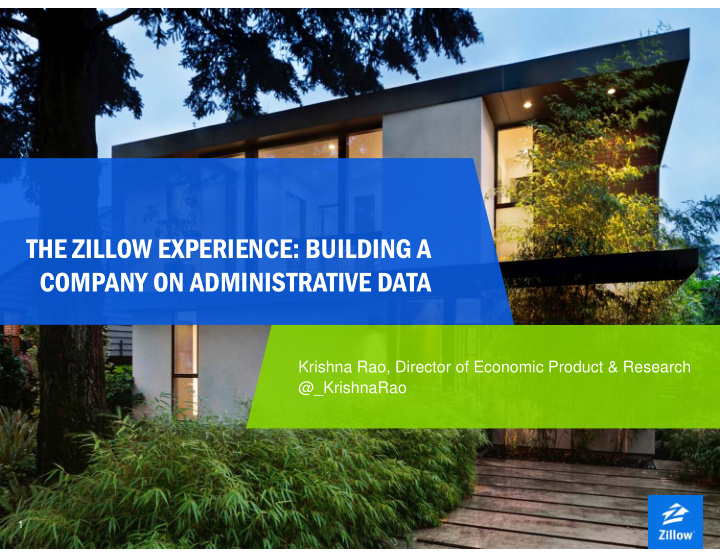



THE ZILLOW EXPERIENCE: BUILDING A COMPANY ON ADMINISTRATIVE DATA Krishna Rao, Director of Economic Product & Research @_KrishnaRao 1
ZILLOW DATA 2
Zillow is built on a backb Zillow is built on a backbone of administrative dat one of administrative data • Start with administrative county records – Sales – Tax assessments – Etc. • Combine with other sources of data – Multiple Listing Services and real estate brokerages – Census and other government data – User submitted data • Results in the ‘Living Database of all Homes’ – The core of the company 3
Produce insight fr Pr oduce insight from dat om data Identifying only valid, arms-length transactions CLEANING Physical attributes Data from multiple Tax assessments sources SCORING Prior sale prices TRAINING Models applied to all Models trained with homes every day recently sold data Value: Range: ZESTIMATE: $478K - $587K $548,874 4
A philosophy on dat A philosophy on data • Built on open data – Census data we use regularly: • American Communities Survey/Current Population Survey/etc. • Housing Vacancy Survey/American Housing Survey/Survey of Construction/etc. • Zillow is committed to freeing data whenever and wherever possible – Data wants to be free • Paying open data forward: – Aggregated housing market statistics openly available – Housing micro (parcel) data for academic research and institutional partnerships 5
Keep the lights on by connecting consumer ep the lights on by connecting consumers to pr s to professionals ofessionals 6
Aggregate gregated real est d real estate dat te data is a is freely av freely available at ailable at www www.zillow zillow.co .com/dat /data Metrics • Zillow Home Value Index • Zillow Rent Index • Zillow Home Value Forecast • Negative equity • List prices • Sale prices • Rental prices • Home sales • $ value/square foot • $ price/square foot • % listings with price cuts • % amount of listing price cuts • % homes sold for loss/gain • % homes foreclosed • % sales that are foreclosure re-sales • % homes increasing/decreasing in value • % homes sold in the past year • Price-to-rent ratios • Price-to-income ratios • Median rental listing prices by bedrooms • For-sale inventory 7
Zillow Home V Zillow Home Value and lue and Rent Inde nt Indexes The Zillow Home Value index is available at a monthly frequency for the nation, states, metro areas, counties, cities, ZIP codes and neighborhoods. 8
chers searcher Academic Resear Academic R 9
Academic Resear Academic R searcher chers A Living Dat A Living Database abase The Zillow Transaction and Assessment Dataset (ZTRAX) is a trove of previously inaccessible or prohibitively expensive housing data Zillow is opening up to qualifying academic and institutional researchers for free 10
Zillow Government and Academic Collaborations Zillow Government and Academic Collaborations 11
LESSONS 12 12
What we have learned along the w What we have learned along the way? y? • How relevant is our experience? – Different in important ways but similar in many ways (more on next slide) • Lack of consistency in local local data creates a challenge – Often forces usage of the lowest common denominator • Need to understand if the problem is data vs analytics/modeling – Statistics vs Machine Learning • The fixed vs variable costs of platforms/architecture – Flexibility of platform is paramount 13
Dif Different but similar erent but similar Data Series Current Source Zillow Equivalent Census/BLS/BEA Bureau of Labor Statistics - Owners Equivalent Rent Zillow Rent Index Consumer Price Index Bureau of Economic Analysis - Value of Housing Services Zillow Rent Index Personal Consumption Expenditures American Communities Survey – Estimated Value of Homes Zestimate - Model Estimate Owner Estimate Year Built of Home American Communities Survey Zillow Living Database of All Homes Real Estate Taxes American Communities Survey Zillow Living Database of All Homes Other House Characteristics American Communities Survey Zillow Living Database of All Homes 14
Discussion questions Discussion questions • What lessons can we learn from others’ experiences? • What does the ideal world look like? – Competing interests: respondent burden, accuracy, cost, etc. – Is there a model that does this well? – Long vs short term vision • How to leverage this effort to build awareness of the data (how is it used and how can it be used)? – Potential for mutual benefit to administrative and other partners 15
16 16
Recommend
More recommend